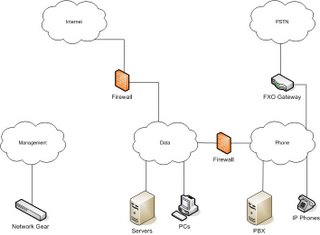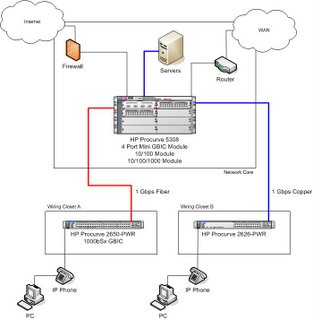Tuesday, October 31, 2006
Pingtel Announces Amazon.com installing sipXchange ECS
The deployed system is a High Availability implementation utilizing 2 registration / authentication proxy servers with a separate media server for voicemail and auto attendant.
http://www.pingtel.com/page.php?id=70&view=122
Monday, October 23, 2006
Windows Mobile 5.0® SIP-Based Dual-Mode Phone: hipi-2200™
Here's a link: http://www.parawireless.com/hipi-2200.htm
New Polycom 650 phones
Saw and played with these at VON. Sound quality is awesome!
Here's some of the marketing stuff...
Revolutionary Voice Quality The SoundPoint IP 650 is the first IP phone to use Polycom’s revolutionary HD Voice technology that delivers voice communications of life-like richness and clarity.
Advanced Features and Applications The phone’s SIP 2.0 software fully supports Microsoft Live Communications Server 2005 for telephony and presence, and integrates with Microsoft Office Communicator instant messenger client. The SoundPoint IP 650 features a USB port for future applications.
Enhanced Call Handling Capabilities The SoundPoint IP 650 accommodates 6 lines in a standalone mode and up to 12 lines when equipped with SoundPoint IP Expansion Modules, as an attendant console. The phone supports shared call / bridged line appearances as well as busy lamp field (BLF) functionality that enables phone attendants to monitor and manage calls more efficiently.
Expandability When equipped with up to three SoundPoint IP Expansion Modules, the SoundPoint IP 650 delivers the advanced call handling capabilities and enhanced user interface of a high-performance attendant console. (note, haven't seen the updated expansion modules yet... I assume they will be backlit as the new phone is)
Intuitive User Interface The SoundPoint IP 650 delivers all of its capabilities through an intuitive user interface, featuring a high-quality backlit 320x160 graphical grayscale LCD display, an easy-to-navigate menu, and a combination of dedicated keys and context-sensitive soft keys for one-button access to essential telephony features.
Fonality Acquires trixbox
See full press release here: http://www.fonality.com/press.html
Thursday, August 17, 2006
Creator of Ethereal(R) Joines the WinPcap team; Wireshark is Born
Wireshark's home is http://www.wireshark.org/. Enhanced and improved, Wireshark is the ultimate tool of choice for network troubleshooting, protocol development, and education worldwide. The unique partnership of Wireshark and WinPcap brings a new synergy, power, and benefits to the open-source community and industry. The upcoming version of Wireshark will be 0.99.1. A pre-release version is available right now at www.wireshark.org.
"I am indebted to core development team of Ethereal® for joining me to work on Wireshark. With their help and contributions from the user community, we're set to continue our success in building the world's leading open-source network protocol analyzer. We have lots of new and exciting things planned for Wireshark! I'm also really excited about joining CACE. Loris and Gianluca are well respected in the community, and it will be great to work with them. As an added bonus, Davis is a great place for my wife and me to raise our daughter," said Gerald.
"We’re thrilled to welcome Gerald to CACE Technologies and expect to do great things together. The sky’s the limit," said Loris.
ABOUT CACE Technologies - CACE Technologies, http://www.cacetech.com/, is an innovative and dynamic company specialized in low-level networking solutions. We are experts in Windows and Linux device driver and network monitoring tools development.
CONTACT: John Bruno, CACE Technologies, john.bruno @ cacetech.com
Tuesday, July 11, 2006
Nerd Vittles Newbie's Guide to TrixBox 1.1 and freePBX
Everything is free except the hardware on which to run your new system. That can be almost any old Pentium PC or a multi-processor RAID box with mainframe horsepower. We also want to get TrixBox properly configured to support our next free application: TrixBox MailCall.
It'll let you retrieve and play back your email messages using any touchtone telephone and your TrixBox 1.1 system. And, yes, you'll need TrixBox 1.1 to make everything work.
To be fully nerded: http://nerdvittles.com/index.php?p=140
Monday, July 03, 2006
Voip Deployment - The Virtual Network
So why would you bother use them? For the quality of the deployment (QOD? :-). By logically segmenting the voice and data worlds disruptions in either world will not affect each other (hopefully). You can firewall or use access lists between VLANs to help secure your VoIP deployment. Also, if you want DHCP / DNS to work differently for the phone system it doesn’t affect the data network.
I’m not going to get into the intricacies of VLANs here. Here’s the wikipedia entry (http://en.wikipedia.org/wiki/Vlan) which will help a bit. Get a couple of switches that support VLANs and play with them a bit… learn how to trunk VLANs between switches and how to statically map ports into VLANs. Learn them, live them, love them… you’ll use them all of the time.
On most VoIP deployments I’ll use 3 VLANs at a minimum. Data, Phone and Management. Data is the default VLAN and used for all PC’s, servers & printers. Phone is for all phones, gateways & PBX equipment. Management is for switch / router management IP’s.
Here’s what the VLAN diagram would look like:

Statically map the PBX and gateway ports into the Phone VLAN. Setup all of the ports that will connect to PC’s and phones with the Data VLAN as the default VLAN (untagged) and the Phone VLAN as a tagged VLAN. That means that devices ‘tagging’ their traffic for the Phone VLAN will be placed in that VLAN and devices that don’t know how to tag their traffic will be in the Data VLAN.
Manually set your IP phones to be in the Phone VLAN. This means the phone will tag it’s traffic for that VLAN and pick up DHCP from that VLAN. It is possible for some phones to pick this up off of the initial DHCP reply to the phone and then switch to the Phone VLAN and get another DHCP address from that VLAN. However, now you are depending on the DHCP server on the Data VLAN to be working.
Saturday, July 01, 2006
Voip Deployment - The Physical Network
Cabling - Make sure your network cabling is up to standards. Properly run Cat 5/5e/6 cabling with patch panels in the closets & wall jacks on the wall. Use manufactured patch cords. And if you really want to be sure it is right, have it certified by a cabling contractor.
Network Switching - This is one of the harder pieces and critical to the success of your deployment. I won't pretend to be able to describe how to properly design a network in a few paragraphs because every organization is different. Here are some basics though.
- Think about the core of your network. If everything ties back to a single location things are pretty simple. Where are your servers, your wiring closets, your wide area connectivity & your outside world connectivity? Start at the core and work out from there with a simple star topology (don't try to connect closet to closet to closet, instead connect each closet to the core directly).
- What other critical line of business applications do you run that may need to be considered in the design.
- What do you have for existing equipment that you might be able to utilize?
- Figure out which manufacturer's gear you want to utilize and learn the different models and their options. This is important! Know your product!
- How are you going to power your hard phones? PoE switches, mid-spans (power injectors) or power bricks at each desk?
- How about power protection? Most UPS manufacturers have calculators on their web sites that allow you to estimate consumption and run times of their gear.
Here's an example of a physical network design with a core server room (the core closet area is sometimes referred to as the MDF and the remote closets as IDFs).

Above we see the two closets linked back to the core at 1 Gbps, one with fiber because of distance from the core, and the second with Cat 5e / 6 copper. The servers all connect in to the core network switch at 1 Gbps and the firewall and router connect in to the core. Simple, clean efficient.
I like the HP switching gear (it's about 60% of the cost of an equivalent Cisco design, lifetime replacement, support and software updates). They have a nice broad range of products, their QOS seems pretty good and they are easy to configure. Don't' get me wrong, I like the Cisco stuff too and design plenty of networks with it. I just think I get more bang for the buck with HP. If I need to cheap things out, Linksys has some inexpensive managed PoE switches and so does Dell, Netgear and DLink.
Try to stick with managed switches so that you can create VLANs. Most modern managed switches will support Quality of Service (QOS). Some of the really cheap PoE switches are unmanaged (Netgear, DLink have some models like that).
Adtran makes some nice little stackable PoE switches (1224 series) and they even have one with an integrated router module (1224 r). This makes for a nice all in one device at remote WAN connected locations.
Don't have the coin for all new fancy gear? First off, prepare yourself for small voice quality issues. If you can live with that (hey we all put up with cell phones right?), take the above network design principles into account. Good cabling, star topology, avoid linking switch to switch to switch. Oh, and forget about trying to use any old hubs you have... switches only.
Remember, cabling and switching are the foundation of your VoIP deployment. The rest of the house is only as good as the foundation. Take the time to get it right and people won't be reaching for your throat. Next article I'll get into VLAN design and maybe QOS... we'll see how long it runs...
Sunday, June 25, 2006
Snapanumber
Snap works by sending the phone number you wish to dial to your PBX and initiating a call back to your phone. Once your phone rings you pick it up and it will be connected to the number you dialed.
For Outlook users, the call pop-ups are tightly integrated.The flexibility comes from it's Multi-Connection technology. If you travel between work and home, or would like to have seperate settings for different situations then this feature will be extremely useful for you. You simply dial via a different connection by using the "arrow" to the right of the Dial button to access these connections.
The latest version of the product (0.7) adds TAPI (in the Pro version $29.95) and eyeBeam 1.5 integration.
Link to their web site: http://www.snapanumber.com/
Wednesday, June 14, 2006
Paragon GSM / WiFi phone launched
Paragon reports that the phone has been tested in the United States with some 30 different SIP infrastructures and providers.

The phone also sports PDA functionality with e-mail, calendar, a web browser and a camera (1.3 M pixel).
The software in the phone is based on Linux. At its core, the phone utilizes an Intel PXA271 processor.
Battery life was worked on extensively with the phone. Apparently 70 to 100 hours of standby time can be had, even with both radios turned on.
Here are the impressive published specs... http://www.parawireless.com/dmen.htm
Paragon has recently opened an office in Dallas with two employees and has approximately 40 employees in China. http://www.parawireless.com